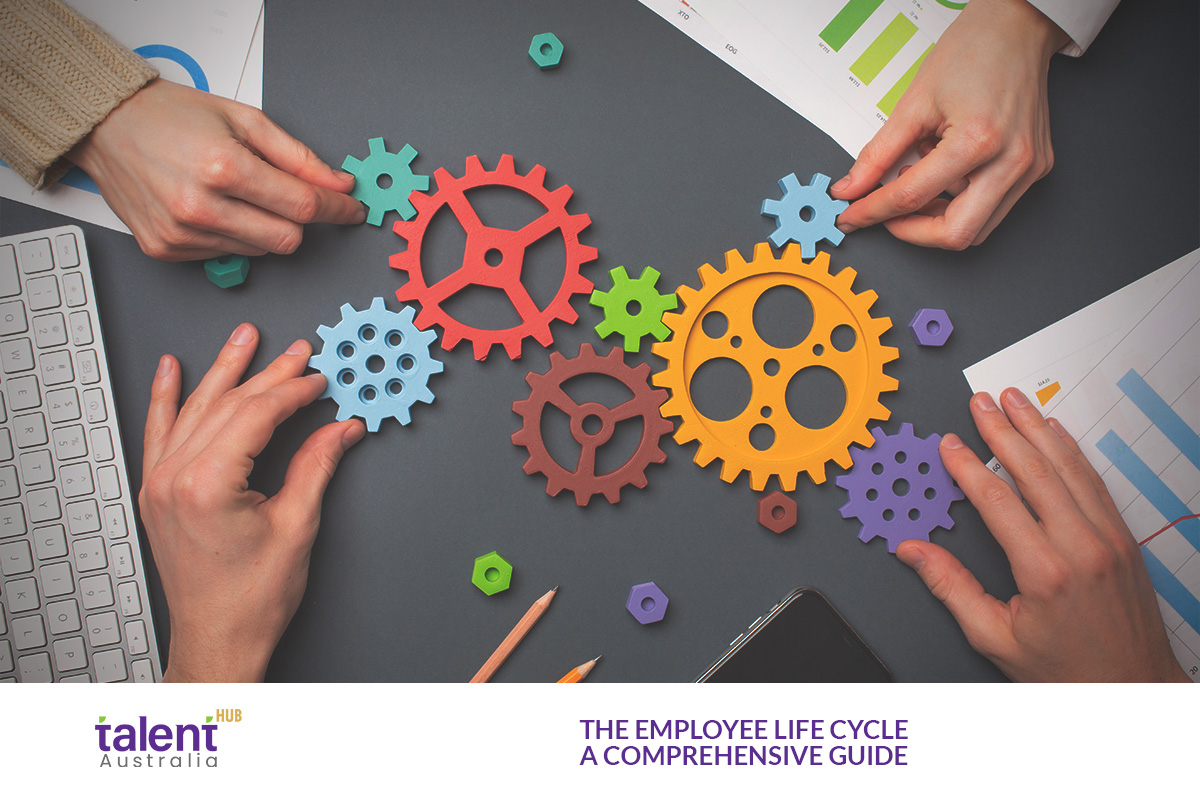
The employee life cycle (ELC) represents the journey that employees undergo from their first interaction with an organisation to the time they exit. By understanding the different stages of this cycle, employers can ensure a positive employee experience, foster engagement, and create a productive work environment. Let’s dive into each phase of the employee life cycle and explore the significance of each step.
Attraction: Building Interest
Attracting the right talent is the first step in the employee life cycle. This stage begins well before candidates even consider applying for a job and involves promoting a strong employer brand to draw potential employees.
Key strategies include:
- Employer Branding: A company’s reputation and brand in the job market is crucial. Highlight your organisation’s culture, values, and work environment.
- Effective Job Postings: Write clear, detailed, and inclusive job descriptions to accurately reflect the role and encourage diverse candidates.
- Multi-Channel Recruitment: Use various platforms, including job boards, social media, and referrals, to reach a broader audience of potential candidates.
The impression an organisation makes during the attraction stage can directly influence the calibre of applicants and the overall success of the hiring process.
Application: First Contact
Once candidates are drawn in, the next phase involves getting them through the application process. This is a critical step where organisations filter through potential hires to find the right fit for their roles.
Key steps in this phase:
- Resume Screening: Identify candidates who possess the required skills, qualifications, and experience.
- Skills Assessments: Tests or practical tasks can help evaluate an applicant’s ability to perform key job functions.
- Interviews: A structured interview process ensures that candidates are assessed not only for their technical skills but also for cultural fit.
- Background and Reference Checks: Validating a candidate’s background and past performance can help ensure their suitability.
Simplifying the application process and maintaining clear communication is key to keeping top talent engaged and preventing candidate drop-offs.
On boarding: Setting the Foundation
The on boarding phase is critical to integrating new hires into your organisation. This stage begins once a candidate accepts the offer and continues until they are fully acclimatised to their role and the workplace culture.
Key elements of effective on boarding include:
- Orientation Programs: Help new employees understand company values, goals, and expectations.
- Training and Mentoring: Ensure new hires are equipped with the necessary skills and knowledge to succeed.
- Clarification of Job Roles: Clear communication about responsibilities and performance expectations helps new employees adapt smoothly.
A positive on boarding experience can enhance employee engagement and retention from the outset.
Development and Growth: Continuous Learning
Once an employee is settled, their professional development becomes crucial. Organisations that invest in the growth of their employees are more likely to retain top talent and foster innovation.
Key initiatives during this stage:
- Training and Development Programs: Provide opportunities for employees to up skill and stay competitive within the industry.
- Clear Career Pathways: Show employees how they can progress within the organisation by offering promotions, leadership roles, and internal mobility.
- Mentorship: Implement mentorship programs to guide employees in their professional growth.
Development ensures that employees remain motivated and engaged, while also contributing to the company’s success.
Performance Management and Feedback: Ongoing Improvement
Providing regular feedback and evaluating employee performance is essential for maintaining productivity and job satisfaction. Performance management should be more than just annual reviews.
Effective performance management includes:
- Continuous Feedback: Regular check-ins and feedback sessions help employees stay on track and address any concerns early on.
- Recognition and Rewards: Acknowledge achievements to motivate employees and enhance engagement.
- Constructive Criticism: Use feedback to identify areas of improvement and provide support for employee development.
Frequent, meaningful performance conversations build trust and help employees feel valued.
Retention and Engagement: Keeping Talent Happy
Retaining employees is more cost-effective than constantly recruiting new ones. High employee engagement leads to higher productivity, stronger company loyalty, and lower turnover rates.
Key strategies for retention include:
- Work-Life Balance: Offer flexible working hours, remote work options, and mental health support to create a positive work environment.
- Employee Recognition: Implement recognition programs to celebrate milestones and achievements, boosting morale.
- Career Growth Opportunities: Ensure employees have room to grow and develop within the organisation to keep them motivated.
A strong focus on employee engagement will improve overall satisfaction and reduce the risk of attrition.
Exit and Off boarding: A Graceful Goodbye
The final stage of the employee life cycle involves the off boarding process when an employee decides to leave. How you handle this phase can significantly impact your company’s reputation and the possibility of future re-engagement.
Steps to a successful off boarding process include:
- Exit Interviews: Gather feedback from departing employees to understand the reasons for their departure and identify areas for improvement.
- Smooth Transition: Ensure a seamless handover of responsibilities to minimise disruption.
- Alumni Networks: Stay connected with former employees through alumni programs. This can lead to rehiring or brand advocacy in the future.
A thoughtful off boarding process helps maintain positive relationships, even after employees have left the organisation.
Conclusion: Optimising the Employee Life Cycle
The employee life cycle is a vital framework that enables organisations to attract, retain, and nurture their talent effectively. By paying close attention to each stage—from attraction to off boarding—businesses can enhance employee satisfaction, build a strong workplace culture, and improve overall performance.
At Talent hub, we understand the importance of creating an exceptional employee experience at every stage. Whether you need help with recruitment, on boarding, or performance management, our expert solutions are designed to help you cultivate a thriving workforce.
